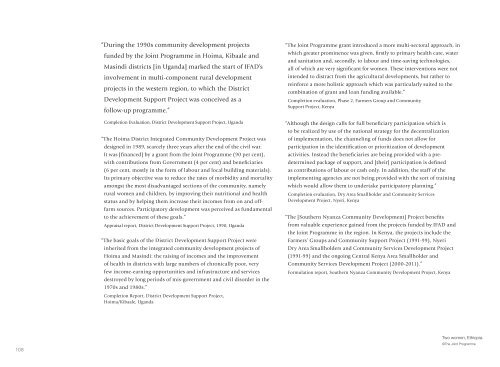You also want an ePaper? Increase the reach of your titles
YUMPU automatically turns print PDFs into web optimized ePapers that Google loves.
“During the 1990s community development projects<br />
funded by the Joint Programme in Hoima, Kibaale and<br />
Masindi districts [in Uganda] marked the start of <strong>IFAD</strong>’s<br />
involvement in multi-component rural development<br />
projects in the western region, to which the District<br />
Development Support Project was conceived as a<br />
follow-up programme.”<br />
Completion Evaluation, District Development Support Project, Uganda<br />
“The Hoima District Integrated Community Development Project was<br />
designed in 1989, scarcely three <strong>years</strong> after the end of the civil war.<br />
It was [financed] by a grant from the Joint Programme (90 per cent),<br />
with contributions from Government (4 per cent) and beneficiaries<br />
(6 per cent, mostly in the <strong>for</strong>m of labour and local building materials).<br />
Its primary objective was to reduce the rates of morbidity and mortality<br />
amongst the most disadvantaged sections of the community, namely<br />
rural women and children, by improving their nutritional and health<br />
status and by helping them increase their incomes from on and offfarm<br />
sources. Participatory development was perceived as fundamental<br />
to the achievement of these goals.”<br />
Appraisal report, District Development Support Project, 1990, Uganda<br />
“The basic goals of the District Development Support Project were<br />
inherited from the integrated community development projects of<br />
Hoima and Masindi: the raising of incomes and the improvement<br />
of health in districts with large numbers of chronically poor, very<br />
few income-earning opportunities and infrastructure and services<br />
destroyed by long periods of mis-government and civil disorder in the<br />
1970s and 1980s.”<br />
Completion Report, District Development Support Project,<br />
Hoima/Kibaale, Uganda<br />
“The Joint Programme grant introduced a more multi-sectoral approach, in<br />
which greater prominence was given, firstly to primary health care, water<br />
and sanitation and, secondly, to labour and time-saving technologies,<br />
all of which are very significant <strong>for</strong> women. These interventions were not<br />
intended to distract from the agricultural developments, but rather to<br />
rein<strong>for</strong>ce a more holistic approach which was particularly suited to the<br />
combination of grant and loan funding available.”<br />
Completion evaluation, Phase 2, Farmers Group and Community<br />
Support Project, Kenya<br />
“Although the design calls <strong>for</strong> full beneficiary participation which is<br />
to be realized by use of the national strategy <strong>for</strong> the decentralization<br />
of implementation, the channeling of funds does not allow <strong>for</strong><br />
participation in the identification or prioritization of development<br />
activities. Instead the beneficiaries are being provided with a predetermined<br />
package of support, and [their] participation is defined<br />
as contributions of labour or cash only. In addition, the staff of the<br />
implementing agencies are not being provided with the sort of training<br />
which would allow them to undertake participatory planning.”<br />
Completion evaluation, Dry Area Smallholder and Community Services<br />
Development Project, Nyeri, Kenya<br />
“The [Southern Nyanza Community Development] Project benefits<br />
from valuable experience gained from the projects funded by <strong>IFAD</strong> and<br />
the Joint Programme in the region. In Kenya, the projects include the<br />
Farmers’ Groups and Community Support Project (1991-99), Nyeri<br />
Dry Area Smallholders and Community Services Development Project<br />
(1991-99) and the ongoing Central Kenya Area Smallholder and<br />
Community Services Development Project (2000-2011).”<br />
Formulation report, Southern Nyanza Community Development Project, Kenya<br />
108<br />
Two women, Ethiopia.<br />
©The Joint Programme

















